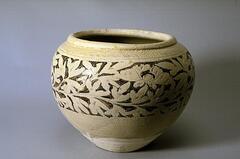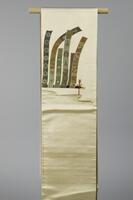10 UMMA Objects
10 UMMA Objects

Chinese (Chinese (culture or style))
Bowl
14th century
Gift of Toshiko Ogita in memory of Tomoo Ogita
1987/1.306
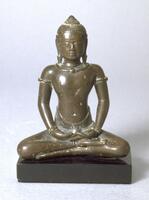
Khmer (Khmer (general))
Buddha, seated in the ardha padmasana pose, in dhyana mudra
1067 – 1099
Museum purchase, Acquisition Fund
1974/2.31
![<p>The inner surface of this bowl features an incised design of two parrots with long tails resembling phoenixes. e entire body of the bowl was glazed including the rim of the foot, on which remain three quartzite spur marks. Although some fireclay has fallen inside the kiln during ring and adhered to the inner surface of the bowl, the state of sintering is good. The piece as a whole is a high-quality ware with a glossy surface and a fine color of glaze. The base of the foot is cracked which occurred while drying before the application of glaze.<br />
[<em>Korean Collection, University of Michigan Museum of Art </em>(2014) p.94]</p>
high quality, incised, double-parrot motif shallow bowl, nice shallow fully glazed foot, three spur marks, firing discoloration, kiln trash fall on glaze, 11th century. <p>The inner surface of this bowl features an incised design of two parrots with long tails resembling phoenixes. e entire body of the bowl was glazed including the rim of the foot, on which remain three quartzite spur marks. Although some fireclay has fallen inside the kiln during ring and adhered to the inner surface of the bowl, the state of sintering is good. The piece as a whole is a high-quality ware with a glossy surface and a fine color of glaze. The base of the foot is cracked which occurred while drying before the application of glaze.<br />
[<em>Korean Collection, University of Michigan Museum of Art </em>(2014) p.94]</p>
high quality, incised, double-parrot motif shallow bowl, nice shallow fully glazed foot, three spur marks, firing discoloration, kiln trash fall on glaze, 11th century.](/media/W1siZiIsIjIwMjIvMDkvMjQvNWdrcXY3YnBzbV9kZWZhdWx0LmpwZyJdLFsicCIsInRodW1iIiwiMjQweDIwMCJdXQ?sha=3c44f3270b71b87f)
Korean (Korean (culture or style))
Bowl with incised pattern of paired phoenixes
1067 – 1132
Gift of Bruce and Inta Hasenkamp and Museum purchase made possible by Elder and Mrs. Sang-Yong Nam
2004/1.215
![<p>This celadon bowl is decorated with mold-impressed designs, which was one of popular type of dishes in 11th and 12th centuries. On its inner walls are lotus scroll designs, and on its inner base is what is presumed to be a lotus flower design. Glaze has been applied all the way down to the rim of the foot, which retains traces of silica supports in three places. The yellow-green glaze is evenly spread on the surface, while the clay is of specially selected high quality, producing a smooth surface.<br />
[<em>Korean Collection, University of Michigan Museum of Art</em> (2014) p.111]</p>
<br />
shallow lobed bowl with molded lotus design on wall, 6 lobes, very small foot, high quality, need cleaning <p>This celadon bowl is decorated with mold-impressed designs, which was one of popular type of dishes in 11th and 12th centuries. On its inner walls are lotus scroll designs, and on its inner base is what is presumed to be a lotus flower design. Glaze has been applied all the way down to the rim of the foot, which retains traces of silica supports in three places. The yellow-green glaze is evenly spread on the surface, while the clay is of specially selected high quality, producing a smooth surface.<br />
[<em>Korean Collection, University of Michigan Museum of Art</em> (2014) p.111]</p>
<br />
shallow lobed bowl with molded lotus design on wall, 6 lobes, very small foot, high quality, need cleaning](/media/W1siZiIsIjIwMjIvMDkvMjQvMmx1M2ptNHMzM19kZWZhdWx0LmpwZyJdLFsicCIsInRodW1iIiwiMjQweDIwMCJdXQ?sha=2ba2ecc35e4531c3)
Korean (Korean (culture or style))
Saucer with molded floral design in center and lining rim
1050 – 1150
Gift of Bruce and Inta Hasenkamp and Museum purchase made possible by Elder and Mrs. Sang-Yong Nam
2004/1.223
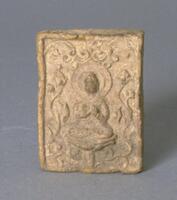
Chinese (Chinese (culture or style))
A Votive plaque depicting the Buddha Amitâbha (Chinese, Amitofou) preaching in his Western Paradise
618 – 907
Gift of Mrs. Caroline I. Plumer for the James Marshall Plumer Collection
1964/2.18

Chinese (Chinese (culture or style))
Ge (halberd)
8400 BCE
Museum purchase from the collection of Max Loehr
1960/2.110A&B
![<p>A circle is incised on the wide inner base of this bowl; the base is decorated with a chrysanthemum floret and is surrounded by lotus scrolls on the wall. There is a crack on the inner base which formed during firing, but the overall state of sintering is fine. There are six refractory spur marks on the foot. Part of the mouth had been broken off and restored.<br />
[<em>Korean Collection, University of Michigan Museum of Art </em>(2014) p.95]</p>
The celadon bowl is close in shape to a perfect hemisphere, and its rim is turned very slightly outward. There is a peony design on the wall and bottom. The color is olive grey. It has a small concave foot. <p>A circle is incised on the wide inner base of this bowl; the base is decorated with a chrysanthemum floret and is surrounded by lotus scrolls on the wall. There is a crack on the inner base which formed during firing, but the overall state of sintering is fine. There are six refractory spur marks on the foot. Part of the mouth had been broken off and restored.<br />
[<em>Korean Collection, University of Michigan Museum of Art </em>(2014) p.95]</p>
The celadon bowl is close in shape to a perfect hemisphere, and its rim is turned very slightly outward. There is a peony design on the wall and bottom. The color is olive grey. It has a small concave foot.](/media/W1siZiIsIjIwMjIvMDkvMjQvNXl3NXZucWgyZl9kZWZhdWx0LmpwZyJdLFsicCIsInRodW1iIiwiMjQweDIwMCJdXQ?sha=252796f0a02b862c)
Korean (Korean (culture or style))
Bowl with incised floral pattern on interior bottom and sides
1050 – 1150
Gift of Bruce and Inta Hasenkamp and Museum purchase made possible by Elder and Mrs. Sang-Yong Nam
2004/1.224
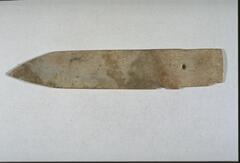
Chinese (Chinese (culture or style))
Dagger-axe (Ko)
8400 BCE
Museum purchase from the collection of Max Loehr
1960/2.119
Loading…
